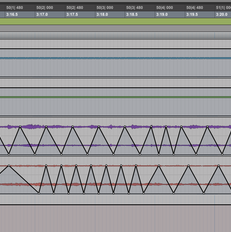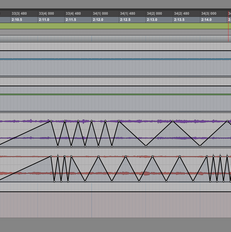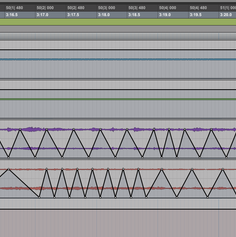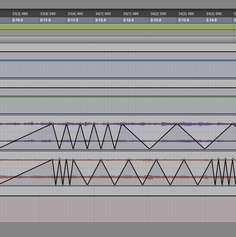Spektralkompass
Spektralkompass is a series of works exploring spectral qualities in different playing techniques on the double bass. The musical skeleton (presented in Spektralkompass 1) consists of two sine tones that start in unison on the note D3 and move slowly apart in a long, continuous glissando movement until they end up on the notes D2 and D4. The double bass lines in all the works imitate the sine tone glissandi and adds various sonic phenomena such as beatings, multiphonics, and a bowing technique called «spectral phase difference». Several of the techniques are relatively unknown, and little explored in acoustic music. The idea for the series came after a friend and colleague, the Mexican bass player Rodrigo Mata commissioned a piece for his bass ensemble Mushamukas. I was asked to write a piece that was somehow inspired by Stefano Scodanibbio and ended up with thinking about his multitrack work for CD called Oltracuidansa. I imagined Oltracuidansa being inspired by Fernando Grillo’s piece Paperoles as both works are based on a large number of more and less personal playing techniques. And similarly, Spektralkompass originates in techniques and sounds that continues to inspire me.
The first piece I wrote was Spektralkompass 5, which was composed for the ensemble Mushamukas. It also turned out to be one of the most conclusive works in the series, incorporating several different techniques at once. Specifically, I am working with multiphonics and a bowing technique called «spectral phase difference bowing», which is a specific flautando bowing, played rhythmically (like a slow rhythmical tremolo). This should give the impression of hearing two consecutive attacks for each stroke, and potentially bringing out the harmonic spectrum.
The playing techniques used in Spektralkompass comes from a mixed origin. I have earlier been using some of the techniques a lot (like multiphonics), but others I have spent years looking for ways to bring into play. None of them can be said to be household techniques in the world of bass playing, but multiphonics, at least, is gradually getting more known. The «spectral phase difference bowing» on the contrary, is not. But as I see it, the latter technique can be viewed as a variant of the continuous open-string-staccato (bouncing, hitting, brushing etc. the string), used by Scodanibbio in his now iconic and hugely influential piece Voyage That Never Ends. This particular way of playing, which in it's basic form explores the harmonic spectrum of the string, probably originates as one of many variations of a technique used by spectral composers associated with performers like Fernando Grillo in the 1970s and 80s. The particular variant which I use (spectral phase difference bowing) is described by the French bassist and author Jean-Pierre Robert in his book «Modes of playing the double bass» (Ed. Salabert, 1995).
Spektralkompass is an evolving series of music, meaning more will come. New pieces will be added to the digital release of Spektalkompass.
Released on the album Spektralkompass - Sterbendes Hertz
Spektralkompass 1 - Logarithmic Glissando
2022; dur. 7'30''; Two Sine Tones; Score at NB Noter
Spektralkompass 2 - Hammer-on Multiphonics, Volume Automation
2022; dur. 7'30''; Two Sine Tones, Two Double Basses; Score at NB Noter
Technique: Hammer-on multiphonics
Volume automation: Randomly selected geographical coordinates on the earth, and number sequences based on longitude and latitude, determine the rhythm in the work. The randomly selected coordinates are notated in the score, and the real-world distance between them determine the space between the rhythmic/automated sections. The rhythm was made as volume automations in Protools.
Hammer-on multiphonics demonstration >
Spektralkompass 3 - Spectral Phase Difference Bowing
2022; dur. 7'30''; Two Sine Tones, Two Double Basses; Score at NB Noter
Technique: Spectral Phase Difference Bowing
A specific flautando bowing, played in the notated rhythm. It gives the impression of hearing two consecutive attackes for each stroke, potentially bringing out the harmonic spectrum.
Spectral phase difference bowing demonstration >
Spektralkompass 4 - Interference Beats
2022; dur. 7'30''; Two Sine Tones, Two Double Basses; Score at NB Noter
Spektralkompass 5 - Spectral Phase Difference Bowing, Multiphonics
2022; dur. 7'30''; Multiple Sine Tones, Four Double Basses; Score at NB Noter
Technique: Spectral Phase Difference Bowing
A specific flautando bowing, played in the notated rhythm. It gives the impression of hearing two consecutive attackes for each stroke, potentially bringing out the harmonic spectrum.
See Spektralkompass 3 for video on this bowing.
Technique: Multiphonics
All four strings on bass 1 and 2 are tuned to D. Within this tuning, I use a techniqued called "combined harmonics and bow-above-finger multiphonics" on the 4., 5., 6. and 7.partial. In addition I created a figure called cross-string harmonics and multiphonics, that sweeps across multiphonics and harmonics on three adjacent strings.
Combined harmonics and bow-above-finger multiphonics >
Bass 1
Cross-string harmonics and multiphonics >
Bass 1
Making of Ecos de Viaje by Ensemble Mushamukas >
Combined harmonics and bow-above-finger multiphonics >
Bass 2
Cross-string harmonics and multiphonics >
Bass 2
Spektralkompass 6 - Glissando in Multiple Octaves, with and without Volume Automation
2022; dur. 7'30''; Six Sine Tones, Eight Double Basses; Score at NB Noter
The use of eight double basses in four different octaves makes an almost cinematic sound. The piece ends on the tone D in six different octaves on the double bass, from sounding D1 to D6.
Volume automation: Randomly selected geographical coordinates on earth, and number sequences based on longitude and latitude, determine the rhythm in the work. The randomly selected coordinates are notated in the score, and the real-world distance between them determine the space between the rhythmic/automated sections. The rhythm was made as volume automations in Protools.




